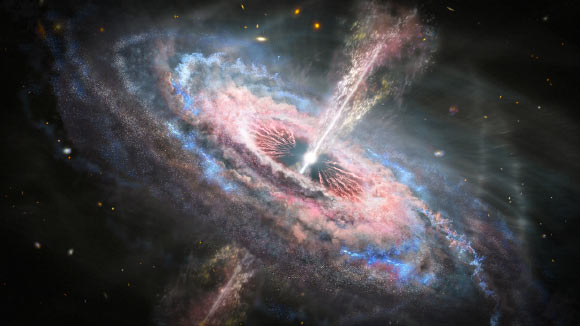Quasars are the ultra-bright cores of distant active galaxies. These objects are among the most distant and luminous objects known. Their central engines are supermassive black holes that are engorged with infalling dust, gas, and stars. Now, astronomers using the NASA/ESA Hubble Space Telescope have discovered extremely energetic outflows that emanate from distant quasars. These outflows tear across interstellar space similar to tsunamis on Earth, wreaking havoc on the galaxies in which the quasars reside.
“Quasars are created when a black hole devours matter, thus emitting intense radiation,” said Virginia Tech’s Professor Nahum Arav.
“Driven by the blistering radiation pressure from the black hole, concussive blasts push material away from the galaxy’s center into outflows that accelerate to breathtaking velocities that are a few percent of the speed of light.”
“These outflows are crucial for the understanding of galaxies’ formation. They are pushing hundreds of solar masses of material each year. The amount of mechanical energy that these outflows carry is up to several hundreds of times higher than the luminosity of the entire Milky Way Galaxy.”
The quasar winds disseminate across the galaxy’s disk, violently sweeping material that otherwise would have formed new stars.
Radiation pushes the gas and dust for far greater distances than scientists previously thought, creating a galaxy-wide event, according to the team.
As this cosmic tsunami slams into interstellar material, its temperature spikes to billions of degrees, where material glows largely in X-rays, but also widely across the light spectrum.
Anyone witnessing this event would see a fantastic show of fireworks.
“You’ll get lots of radiation first in X-rays and gamma rays, and afterwards it will percolate to visible and infrared light. You’d get a huge light show, like Christmas trees all over the galaxy,” Professor Arav said.
Numerical simulation of galaxy evolution suggest that such outflows can explain some important cosmological puzzles, such as why astronomers observe so few large galaxies in the Universe and why there is a relationship between the mass of the galaxy and the mass of its central black hole.
This study show that such powerful quasar outflows should be prevalent in the early Universe.
Aside from measuring the most energetic quasars ever observed, the astronomers also discovered another outflow accelerating faster than any other.
The outflow increased from nearly 43 million mph (69 million kmh) to roughly 46 million mph (74 million kmh) in a three-year period.
The researchers believe its acceleration will continue to increase as time passes.
“There were so many discoveries in the data that I felt like a kid in a candy store,” said Dr. Timothy Miller, a postdoctoral researcher at Virginia Tech.
The findings were published in a series of six papers in the Astrophysical Journal Supplements.
_____
Nahum Arav et al. 2020. HST/COS Observations of Quasar Outflows in the 500–1050 Å Rest Frame. I. The Most Energetic Outflows in the Universe and Other Discoveries. ApJS 247, 37; doi: 10.3847/1538-4365/ab66af
Xinfeng Xu et al. 2020. HST/COS Observations of Quasar Outflows in the 500–1050 Å Rest Frame. II. The Most Energetic Quasar Outflow Measured to Date. ApJS 247, 38; doi: 10.3847/1538-4365/ab596a
Timothy R. Miller et al. 2020. HST/COS Observations of Quasar Outflows in the 500–1050 Å Rest Frame. III. Four Similar Outflows in 2MASS J1051+1247 with Enough Energy to Be Major Contributors to AGN Feedback. ApJS 247, 39; doi: 10.3847/1538-4365/ab5967
Xinfeng Xu et al. 2020. 2020 HST/COS Observations of Quasar Outflows in the 500–1050 Å Rest Frame. IV. The Largest Broad Absorption Line Acceleration. ApJS 247, 40; doi: 10.3847/1538-4365/ab4bcb
Timothy R. Miller et al. 2020. HST/COS Observations of Quasar Outflows in the 500–1050 Å Rest Frame. V. Richness of Physical Diagnostics and Ionization Potential-dependent Velocity Shift in PKS J0352-0711. ApJS 247, 41; doi: 10.3847/1538-4365/ab5969
Xinfeng Xu et al. 2020. HST/COS Observations of Quasar Outflows in the 500–1050 Å Rest Frame. VI. Wide, Energetic Outflows in SDSS J0755+2306. ApJS 247, 42; doi: 10.3847/1538-4365/ab5f68








